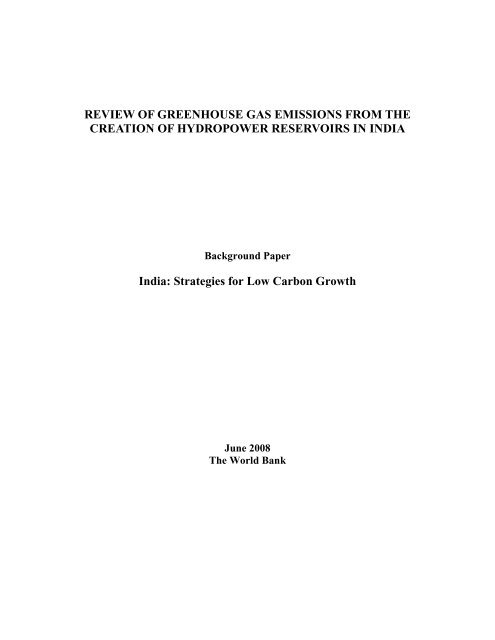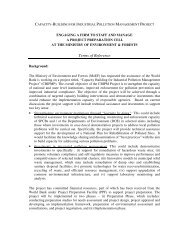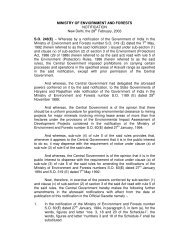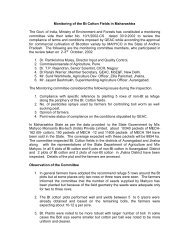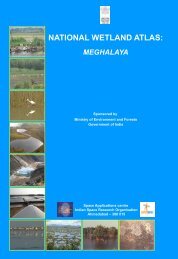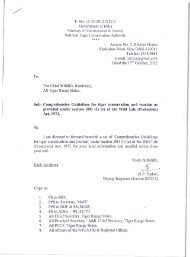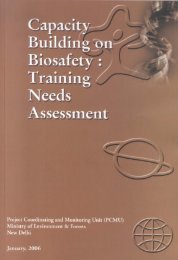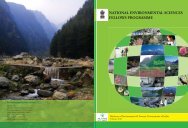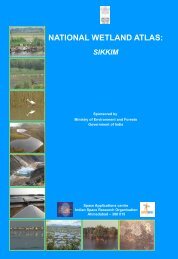REVIEW OF GREENHOUSE GAS EMISSIONS FROM THE ...
REVIEW OF GREENHOUSE GAS EMISSIONS FROM THE ...
REVIEW OF GREENHOUSE GAS EMISSIONS FROM THE ...
You also want an ePaper? Increase the reach of your titles
YUMPU automatically turns print PDFs into web optimized ePapers that Google loves.
<strong>REVIEW</strong> <strong>OF</strong> <strong>GREENHOUSE</strong> <strong>GAS</strong> <strong>EMISSIONS</strong> <strong>FROM</strong> <strong>THE</strong>CREATION <strong>OF</strong> HYDROPOWER RESERVOIRS IN INDIABackground PaperIndia: Strategies for Low Carbon GrowthJune 2008The World Bank
CONTENTSAcknowledgements ..................................................................................................................... iAcronyms and Abbreviations.....................................................................................................ii1.0 Background ....................................................................................................................... 12.0 Mechanisms behind increased emissions of Greenhouse Gases from Reservoirs ............ 23.0 Characteristics of Indian Reservoirs and their GHG Emissions ....................................... 34.0 Conclusions and Recommendations/ Suggested Next Steps............................................. 5Table 1 Distribution and Characteristics of Indian Reservoirs ............................................... 4Annex 1: Predicting Emissions of Greenhouse Gases from Future Hydropower Projects in theMiddle Reaches of Sutlej River ................................................................................................. 71.0 Background ....................................................................................................................... 72.0 Factors that Influence Emissions of Greenhouse Gases.................................................... 83.0 Design Criteria that could Reduce Methane Emissions .................................................. 10
AcknowledgementsThis report was produced as a background paper for the study, India: Strategies for LowCarbon Growth. The team that has worked on this paper comprises the following World Bankstaff and consultants: Bjorn Svensson, Judith K. Plummer and Rohit Mittal. Valuablecomments were received from Alessandro Palmieri, Lars Odegard and Vahid Alavian. Inaddition, that study benefited from the support of Kseniya Lvovsky as former Task TeamLeader for the Study, Mr. Kwawu M. Gaba as the current Task Team Leader, Mr. Charles J.Cormier as the current co-Task Team Leader, Karin Kemper and Salman Zaheer asresponsible Sector Managers, and Isabel Guerrero, Country Director India.i
List of AbbreviationsCDMCH4CO 2FRLGHGGWGWhHPPkWhICOLDIHAIPCCMWN 2 ONPPUNESCOClean Development MechanismMethaneCarbon DoxideFull Reservoir LevelGreen House GasesGiga WattGiga Watt HourHydro Power ProjectKilo Watt HourInternational Commission on Large DamsInternational Hydropower AssociationIntergovernmental Panel on Climate ChangeMega WattNitrogen OxideNet Primary ProductionUnited Nations Educational, Scientific and Cultural Organizationii
a critical evaluation of published results in combination with general ecological knowledgeseems to be the only means of analysing the role of reservoirs in a changing climate.2.0 Mechanisms behind Increased Emissions of Greenhouse Gases from ReservoirsWhen organic soils and vegetation are flooded, decomposition processes commence. As longas oxygen is available, the decomposition of organic matter will result in emissions of carbondioxide. Net emissions from reservoirs are then simply related to the extra carbon contained inthe inundated vegetation and can be easily calculated if the original carbon content and itsoxidation rate in the water is known. Observations indicate that most of the easily degradedorganic matter has disappeared after about 10 years, while wooden material like tree trunks ismore or less refractory, i.e., remains over a very long period of time and thus does notcontribute significant amounts of atmospheric greenhouse gases.In temperate regions, oxygen dissolved in the water is usually large enough to balancedecomposition processes. However, in tropical environments, where reservoirs tend tobecome more or less permanently stratified and the temperature is comparatively high,oxygen will be rapidly used up near the bottom resulting in the initiation of quite differentmicrobial activities, where the end product is methane, a greenhouse gas with a heatingpotential 23 times higher than that of carbon dioxide. Methane is either diffused through thewater column or, more importantly, forms bubbles that emerge from the bottom to the watersurface. Methane dissolved in the water mass is rapidly oxidised when passing oxygenatedwater, whereas bubbles largely resist oxidation. At depths larger than approximately 20 m, thepressure is too high for bubbles to form so there only dissolved methane can exist.The implication of these observations is that net contributions of greenhouse gases to theatmosphere from man-made lakes are the sum of release of extra carbon dioxide and thefraction of carbon leaving the water surface as methane. In deep reservoirs, methanecontributes insignificant amounts of gas to the atmosphere. In this context it should also bementioned that certain environmental conditions can amplify methane emissions. The waterhyacinth is a floating exotic aquatic weed that has invaded many water bodies in India. Whencovering the water surface the water hyacinth reduce the aeration of the water anddecomposing water hyacinths consume large amounts of oxygen.Detailed studies of reservoirs have, however, shown that the picture is more complicated thandescribed above. Organic matter in reservoirs does not consist of flooded vegetation only. Italso derives from so-called allochthonous material, entering the reservoirs through tributariesand emanating from upstream catchments. This organic matter is continuously replenishedand is exposed to the same processes as flooded vegetation. As long as the decomposition ofthe allochthonous material results in the formation of carbon dioxide only, reservoirs will notcontribute to emissions of extra greenhouse gas to the atmosphere though, because the carbondioxide would have formed anyway somewhere within the aquatic system. If, however, afraction of the decomposed material results in the formation of methane, an increased burdenof atmospheric greenhouse gases will result. Again, in deep and stratified reservoirs, themethane is trapped near the bottom and only small amounts will reach the water surface. Inshallow reservoirs with anoxic bottom water, however, oxidation processes are insufficient tokeep pace with methanogenesis and significant amounts of methane might then leave thewater surface.2
It should be mentioned that methane is also naturally emitted from certain ecosystems,notably wetlands. Inasmuch as such environments are inundated, methane emissions canactually decrease after reservoir flooding provided the depth of the reservoir is large enoughand the anoxic layer is not too extensive.In aquatic as well as terrestrial ecosystems there are organisms with the capacity to usedissolved carbon dioxide to synthesise new organic, so-called autochthonous, matter. Hence,on average there will be a net sequestration of carbon that partly counterbalance thedecomposition processes. In arid environments, aquatic primary production is higher than inthe surrounding terrestrial environment, and reservoirs created in such environments mightactually constitute sinks for atmospheric carbon. Likewise, particulate organic matter (bothautochthonous and allochthonous) will sink to the bottom and become buried in thesediments. This route of carbon flow also constitutes a net sink which can be quite significant,leading to removals of a few to several hundred grams of carbon per square meter every year,depending on the ambient climatic and hydrochemical conditions.From what has been described above, one can draw the conclusion that reservoirs’contribution to atmospheric greenhouse gases is extremely variable. The topography, climate,soil and geological conditions as well as land-use constitute the ultimate factors responsiblefor the fate of carbon in reservoirs. In addition, reservoir operation may also be of greatimportance. If, for example, reservoirs supply hydroelectric power stations and use waterwithdrawn from near the bottom where anoxic conditions prevail, vast amounts of methanemay be released below the water outlets or spillways.3.0 Characteristics of Indian Reservoirs and their GHG EmissionsIn India, impoundments cover about 5 million hectares, the majority being located in thesouthern part of the country. About half of this area is occupied by reservoirs that supporthydropower plants, notwithstanding that the majority of dams satisfy multipurpose needs. Thehydropower potential of India is estimated at about 149 GW of which about 23 percent hasbeen exploited. The untapped potential is mainly in alpine environments in the northern partof the country.Indian reservoirs represent the whole spectrum of different reservoir types found in the world.Some are located in alpine environments and share the same features that are typical ofnorthern temperate reservoirs, i.e., can be assumed to release insignificant amounts ofgreenhouse gases. On the other extreme one finds reservoirs in arid environments, wheresequestration probably dominates over release of carbon. Between these extremes arereservoirs located in wet, humid or dry tropical environments. Their performance in terms ofemission of greenhouse gases is more difficult to appreciate. Table 1 provides an overview ofthe characteristics of reservoirs in different Indian states. The data derives from ICOLD’s(International Commission on Large Dams) most recent compilation. Unfortunately, datarelated to Indian dams and reservoirs are incomplete and sometimes erroneous. Obviouserrors have been discarded from the table.Ocular inspections of satellite photos (Google Earth) in combination with information onprevalent climatic conditions indicate that reservoirs in Uttaranchal, Tamil Nadu, Sikkim,Rajasthan, Punjab, Karnataka, Jammu/Kashmir, Himachal Pradesh, Gujarat, and ArunachalPradesh represent categories of surface waters where net emissions of greenhouse gases, tojudge from experiences from other parts of the world, are generally low, and probably3
comparable to those from natural lakes. These reservoirs represent about 40 percent of thetotal storage capacity or 11 percent of the total area occupied by reservoirs in the country. Thediscrepancy between these two percentages indicates that reservoirs in the actual states aredeep compared to remaining reservoirs.Table 1: Distribution and Characteristics of Indian Reservoirs(Reservoir Data from ICOLD, 2007)StateTotal no ofreservoirsof whichcompletedata areavailableReservoirswithhydropower4Climate zoneTotal storagecapacity (BCM)(1)No ofreservoirsyounger than10 yrsWest Bengal 28 3 1 mainly humid subtropical 1,48 0?Uttaranchal 15 11 7 mainly highland 3,06 0?Uttar Pradesh 135 70 5 humid subtropical 15,35 0Tripura 1 0 1 humid subtropical 0,31 0Tamil Nadu 88 64 45 mainly tropical dry 6,5 0?Sikkim 1 0 ? highland 0 0?Rajasthan 84 52 1 mainly arid 8,28 0Punjab 3 0 1? arid and humid subtropical 2,37 1Orissa 151 120 6 tropical wet & dry 17,22 0Meghalaya 4 0 3 humid subtropical 0,7 0Manipur 3 0 ? humid subtropical 0,4 0?Maharashtra 1658 710 33 mainly tropical wet & dry 25,52 75Madhya Pradesh 1259 1124 7 mainly humid subtropical 17,16 18Kerala 44 20 14 tropical wet 5,38 0Karnataka 177 162 10 mainly semi-arid 33,63 0?Jammu & Kashmir 7 1 1 highland 0 0?Himachal Pradesh 5 5 5 mainly highland 13,92 0Gujarat 545 29 2 mainly arid 16,14 0?Goa 6 6 0 tropical wet 0,04 0?Chattisgarh 37 31 3 mainly humid subtropical 6,22 0Bihar & Jharkhand 104 53 5 humid subtropical 4,31 2?Assam 3 2 2 humid subtropical 0,01 0?Arunachal Pradesh 1 0 1 highland 0 0?Andhra Pradesh 121 85 10 mainly tropical wet & dry 27,31 0Andaman & NicobarIslands 1 0 ? mainly tropical wet & dry 0 0?Sum 4481 2548 >162 206,54 (2) ~100(1) Source: Central Water Commission, 2006(2) The storage capacity, when minor irrigation tanks and impoundments are included, amounts to 213 BCM.Ongoing projects will add 76 BCM more.As a matter of fact, there are clear relationships between the main purpose with reservoirs inIndia and their volume to surface area ratio. [It should be remembered that reservoir capacityrefers to live storage as opposed to reservoir volume which also includes dead storage. Dataused in this study and deriving from ICOLD’s database exclusively deals with live storageonly, which means that depth calculations are conservative, i.e., underestimate the real depth.]Reservoirs used for irrigation have an average depth of 7.4m, all states taken together.Hydroelectric reservoirs and those that serve the purpose of both providing water forirrigation and power have an average depth of 18m. About 50 percent of the latter kinds of
eservoirs are located in the states mentioned above, where environmental conditions favourlow emissions of carbon gases. As concluded earlier, dissolved methane is rapidly oxidised inoxygenated water. Aerobic conditions, extending to a depth of about 5 m from the watersurface, have proven sufficient for the full elimination of methane before it reaches the watersurface. Therefore, reservoir depth per se is crucial for a reservoir’s potential to emit methane.As seen in Table 1, few reservoirs are younger than 10 years, notwithstanding the ongoingcreation of new reservoirs and the possible time lag between ICOLD’s compilation and thetimetable of reservoir filling. In other words, decomposing flooded vegetation and soilorganic matter probably play a minor role for the overall carbon balance in existing Indianreservoirs.The most potent, but least easily evaluated source of atmospheric methane from Indianreservoirs is probably the degassing of hypolimnetic (=deriving from near the bottom) waterwhen passing the tailrace or downstream river reaches or canals. The significance of thissource is related to the shape of the reservoir, its hydraulics and the design of the reservoiroutlet. While many other contributions of reservoir emissions of greenhouse gases can bededuced from general experience and easily obtained information, estimates of emissions dueto degassing must be based on analyses of complex site-specific information. Suchinformation is currently not available for Indian reservoirs, or for tropical reservoirs in othercountries except for a few intensively studied ones in South America for that matter.4.0 Conclusions and Recommendations/ Suggested Next Steps1. Estimates of greenhouse gas emissions from Indian reservoirs are underway – (see Annex1). These estimates involve a high degree of uncertainty, among other things dependingon the fact that reliable information is available for comparatively few reservoirs. It isclear, however, that previous estimates that have been circulated in the press overstateemissions from reservoirs in India. In particular, hydropower reservoirs are to a largeextent located in regions where natural conditions restrict processes that give rise tomethane emissions. In addition, such reservoirs are deep and old, factors that also reduceemissions of greenhouse gases. In order to allow more precise estimates it is suggestedthat the characteristics of major reservoirs (at least those with a surface area ≥100 km 2 ) beupdated. Data of particular interest are surface area, reservoir length, average depth andrenewal/throughflow rate. These measures allow a simplified analysis of the risk ofstratification of reservoirs, a prerequisite for the formation of anoxic, methane generatingbottom water as emphasised by Ledec and Quintero in a World Bank report published2003.2. Since methane production is related to the amount of organic matter in reservoirs it is ofvalue to know the size of the catchment upstream from the reservoirs from where theorganic material derives.3. It can be suspected that one of the most important pathways for methane from the water tothe atmosphere is the degassing of water that passes hydropower turbines. Measurementsof methane concentrations near the intake of several power plants should illuminate howimportant this pathway is.5
4. Information on sedimentation rates in reservoirs should be gathered together withestimates of the organic content in order to allow calculations of carbon sequestration insediments.5. Information on the stratification of reservoirs in India should be gathered. It is likely thatthe stratification differs between regions/states.6. Guidelines that allow proper consideration of the greenhouse effect should be produced toassist future environmental impact assessments.6
Annex 1: Predicting Emissions of Greenhouse Gases from Future Hydropower Projectsin the Middle Reaches of Sutlej River1.0 BackgroundTwo workshops hosted by UNESCO/IHA have analysed the scientific basis for estimatingemissions of greenhouse gases from freshwater reservoirs 1 . “With regards to the three speciesof gases of interest (N 2 O, CO 2 and CH 4 ), the participants concluded the following:• Data were presented on the recordings of N 2 O related to freshwater reservoirs ineach of the major climate types. Very small N 2 O emissions had been recorded. It iswell established that the major sources of nitrogen are agricultural fertilizers andurban waste discharges coming from the upstream watershed. It was concludedthat N 2 O emissions need not be included in future reservoir induced GHGresearch.• For CO 2 , it was noted that emissions measured at the reservoir surface largelyrepresented the product of the natural carbon cycle. In a small number oftemperate and cold/boreal reservoirs, absorption of CO 2 had been recorded at thereservoir surface. Measurements on newly created reservoirs showed an increaseof CO 2 emissions with peak values during the first years after impoundment. Itwas understood that this pulse represented the decomposition of submerged flora,although a substantial portion of the remaining biomass will not decompose andwill be preserved by the reservoir water. Another source of the CO 2 is the releaseof carbon from soils in the drawdown zone. In all reservoirs, the peak of thisactivity occurred generally within the first two or three years after commissioning.It was agreed that the net CO 2 emissions were not significant in relation to thelifespan of most reservoirs.• CH 4 is the most significant GHG in relation to reservoirs. In cold/boreal andtemperate reservoirs, little CH 4 emissions have been recorded. In some cold/borealreservoirs, CH 4 emissions have been detected following the break-up of the winterice cover. In some tropical reservoirs, however, significant CH 4 emissions havebeen recorded. There is a high temporal variability in CH 4 emissions, which needsfurther investigation. In at least one case (Petit Saut, French Guyana), significantCH 4 ‘degassing’ emissions have been recorded downstream of the reservoir.However, based on a limited set of published measurements, it seems that sometropical reservoirs exhibited very low CH 4 emissions.”Run-of-the-river hydropower plants do not cause net emissions of GHG except thecomparatively small amounts of such gases released as a result of manufacturing ofequipment and construction work, including transportation. The total amounts of suchemissions usually fall below 10 g CO 2 -equivalents per kWh 2 .1 http://www.unesco.org/water/ihp/pdf/ghg_participants_statement.pdf2 Svensson, B. (2005). Greenhouse gas emissions from hydroelectric reservoirs: A global perspective. pp. 25-37,In: dos Santos, M.A. & Rosa, L.P. (Eds.) Global warming and hydroelectric reservoirs. Proceedings ofInternational Seminar on Greenhouse Fluxes from Hydro Reservoirs & Workshop on Modeling Greenhouse GasEmissions from Reservoir at Watershed Level. Rio de Janeiro, Brazil, 8-12 August 2005. COPPE/UFRJ,Eletrobrás. 197 pp.7
The harnessing of Sutlej River for energy purpose includes, inter alia, three hydropowerplants located between longitudes 77 o 35’E to 77 o 43’E and latitudes 31 o 23’N to 31 o 30’N, viz.the Luhri (capacity rated at 775 MW), Nathpa (1500 MW) and Khab (1020 MW). The KhabDam Project will use a reservoir covering a surface area of 1000 ha and with a gross storageamounting to 625 Mm 3 , while the other two projects are regarded as run-of-the-river HPPalthough Nathpa includes a small dam lake with a gross storage of 3.43 Mm 3 , and covering asurface area of 22.86 ha. The three projects span altitudes from 2760 m (Khab at FRL) to 710m (Luhri) 3 .The meteorological conditions display large variations within the actual reaches of the SutlejRiver although the warm-temperate climate zone is dominant. Air temperatures vary betweennear 0°C in the winter to >40°C in the summer, while the water temperature varies betweenabout 10-20°C 4 .Sutlej is a braided river and lacks aquatic macrophytes. The amount of organic matter in thewater mass is also low. This is because the water is nutrient poor. High turbidity during mostof the year also reduces light penetration which disfavours algal growth 4 .The river valley between Khab and Luhri is steep, with slopes as great as 70°. The climate isgenerally arid, and riparian vegetation is sparse.2.0 Factors that Influence Emission of Greenhouse GasesNet increases of GHG emissions come from flooded, decomposing vegetation and otherorganic matter trapped in the reservoir sediments. Large depth, high turnover of the watermass and low temperature reduce formation of methane, the most important GHG inconnection with river regulation. Removal of the vegetation before flooding will also reduceGHG emissions.The natural flow in the Sutlej River peaks in the summer and is typically between 400 and1,500m 3 /s (extremes as high as 5,000m 3 /s have been recorded in recent years), whereas in thewinter discharges are normally between 70 and 130m 3 /s 5 . There is usually no riparianvegetation below the average summer water level. The seasonal flow variation has a patternthat favourably acts to reduce methane emissions since comparatively high temperaturescoincide with high turnover rate of the water mass, while in the winter temperature will below enough to maintain well oxygenated water.Particles suspended in the water will sink to the bottom in standing water, a phenomenon thatincrease the transparency of the water and facilitate primary production. Therefore, morecarbon will be available in a volume of water following river regulation.3 Rampur Hydropower Project: Executive Summary of EA. Available at http://wwwwds.worldbank.org/external/default/WDSContentServer/WDSP/IB/2007/08/03/000011823_20070803113548/Rendered/INDEX/E14650v7.txt4 Joshi, C.B. (1996). Hydro-biological profile of river Sutlej in its middle stretch in western Himalayas. - UttarPradesh Journal of Zoology 16:97-103.5 Kumar, R. et al. (2007). Flash-Flood Warning for the Upper Sutlej River Basin, Northern India. - NationalSurface Water Conference & Hydroacoustics Workshop, April 2-6, 2007, St. Louis, Missouri, USA. U.S.Geological Survey (USGS), 8 pp.8
A theoretical estimate based solely on a relationship between average net primary productionand latitude [Net Primary Production (NPP - g C per m 2 per yr) = 852 – 11.7*latitude] 6 , andassuming that 20% of NPP is embedded in the sediments 7 , gives a net burial of about 100gCper m 2 annually. However, because of the low concentration of nutrients, it is likely that thisamount overestimates the carbon storage in the Khab Reservoir.Warm temperate forests in their natural state is estimated to contain 371t C/ha 8 . The forestsalong the Sutlej River have been heavily logged and largely consist of shrubs nowadays.Erosion has probably depleted the soil organic matter, including litter and debris. In addition abroad zone on both sides of the river is barren due to the annual flooding. Perhaps less than200 t C/ha remains. This means that the Khab reservoir, unless the area is cleared ofvegetation, would inundate 200,000 t of carbon at most. The decomposition of floodedvegetation is usually completed in less than 10 years, when about 50 % of the organic matterhas disappeared. The remaining fraction is resistant and will not contribute significantamounts of greenhouse gas.How much of the carbon will be emitted as methane to the atmosphere? Since the averagedepth of the reservoir is 62.5m methane emissions through bubbling need not be considered.The only mechanisms that would release methane to the atmosphere are diffusion through thewater mass or degassing below the power station. The importance of these two pathwaysdepends on the oxygen content near the bottom of the reservoir.The inlet to the reservoir will be well oxygenated at all times. The renewal rate of thereservoir in winter is about 70 days, while in the summer it is only 7 days. Methane formationis a slow process compared to aerobic degradation of organic matter. It is likely that oxygenwill be sufficient to prevent methanogenesis in the winter since the reservoir will not bestratified at this time of the year and because of the low temperature. In the summer, on theother hand, when the risk of stratification of the water mass is normally larger, the waterrenewal rate will most likely be high enough to replenish well oxygenated water and preventmassive methane formation.This rough estimate indicate that without forest clearance the specific emissions of CO 2 fromthe Khab Power station would be in the order of 1g per kWh (given an estimated annualenergy generation of 3522 GWh and a reservoir life expectance of 100 years). This figure willbe even lower if the entire cascade of power generation is considered. If we assume that 5%of the carbon will be emitted as methane, the specific emissions will reach about 1.5g CO 2 -equivalents per kWh; not considering the carbon permanently buried in the sediments.3.0 Design Criteria that could Reduce Methane EmissionsIt is unlikely that reservoirs and power stations in the Sutlej River will emit large amounts ofmethane, the only GHG that needs to be considered in hydropower projects. Because of thesteep river valleys in the Himalaya region, depth will always be large enough to prevent6 Lewis, W. M., Jr. (1987). Tropical limnology. - Annual Review of Ecology and Systematics 18:159-184.7 Information given at the UNESCO/IHA workshop in Iguaçu, Brazil in October 2007.8 Estimates of preanthropogenic carbon storage in global ecosystem types compiled by Jonathan Adams,Environmental Sciences Division, Oak Ridge National Laboratory, TN 37831, USA.9
ebullition of methane and dissolved methane will be oxidised before reaching the watersurface.The only remaining escape route for methane in this region is degassing below the powerstation. It is, however, impossible to judge weather this is a real risk since the hydraulics ofreservoirs in this part of the world has not been modelled. Before this has been done one canonly speculate what design modifications that could reduce methane emissions. Surfaceintakes would definitely do the job, but pose practical difficulties. Alternatively, one couldforce well aerated surface water to a bottom intake by installing a shaft or a screen thatseparates the water masses.10


